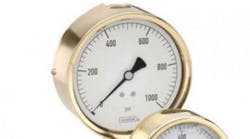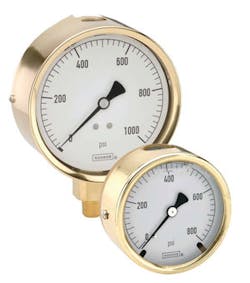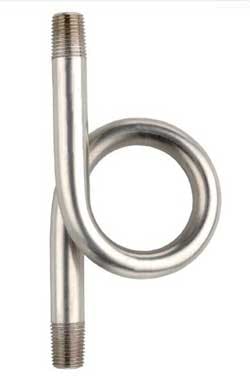This file type includes high resolution graphics and schematics when applicable.
The technology used in today’s pressure gauges has been around since the mid-eighteen hundreds, and the pressure gauge is still one of the most common methods of measuring pressure today. The majority of pressure gauges today still incorporate the Bourdon tube, socket, and geared movement; along with a pointer and dial to indicate process pressure.
Because the pressure gauge is a purely mechanical device, attention to three fluid conditions is necessary. The three factors that can adversely affect accuracy and performance are:
• temperature,
• vibration, and
• pulsation.
Temperature influence
Fluid and ambient temperature is an important consideration when selecting and applying pressure gauges. For every 100 °F shift in temperature from which the gauge is calibrated, you can expect as much as a 2% additional error in the reading. The cause is the change in the elasticity or spring rate of the Bourdon tube element with temperature. Although it is difficult to circumvent the influence of ambient temperature, we can address the influence of fluid temperature.
In steam service, the common practice is to install coil siphons or pigtail siphons to dissipate process heat. Another common practice is to install a diaphragm seal with capillary to separate the gauge from the high heat source. Many options are available with fill fluid in the seal and capillary system to withstand temperatures to 600 °F.
Vibration influence
Vibration from pumps, motors, and other rotating equipment can accelerate wear and premature failure of internal working parts of a pressure gauge, especially the Bourdon tube and the gear and movement mechanism. Vibration can also cause pointer oscillation, which makes it difficult to obtain an accurate reading. One of the most common causes of pressure gauge failure is exposure to continuous vibration.
The most widely accepted remedy is to utilize a liquid-filled pressure gauge. The fill fluid of choice is either glycerine or silicone. Liquid-filled gauges address not only pointer oscillation, but also serve to protect and lubricate the internal geared movement.
Pulsation influence
Process pulsation can occur around the discharge of pumps as well as quick operating valves. Many users assume that liquid filling a pressure gauge will fully address pulsation. Although a liquid-filled gauge helps damp the effects of pulsation, it often does not fully address this fluid condition. Pulsation dampers are installed upstream of the gauge connection, and they can be a piston-type snubber, a sintered metal snubber, or a threaded in-flow restrictor in the socket of the gauge. A needle valve installed upstream of the gauge that is slightly opened is another common practice to address pulsation.
Noshok does not recommend to rely solely on a needle valve to address pulsation because you could inadvertently open the valve, and thereby negate flow restriction. In clean fluids (gases or clean low viscosity liquids) a threaded orifice (flow restrictor) or a sintered metal snubber is the least costly way to address pulsation. In dirtier and higher viscosity fluids a piston snubber is usually installed.
Summary
Temperature, vibration and pulsation are three process conditions that adversely affect a pressure gauge. Being aware of these three process conditions, and taking the necessary steps to address them, can help minimize accuracy errors and add to the service life of the pressure gauge.
This information was provided by Michael Lancaster, Engineering Manager at Noshok Inc., Berea, Ohio. For more information, call (440) 243-0888.
This file type includes high resolution graphics and schematics when applicable.




